Herb Fascination: Bee Balm
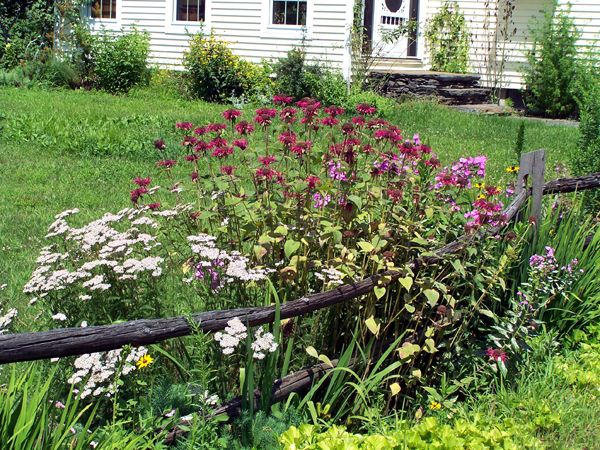
Fence garden August 2009
In my gardens, it was originally planted in the first herb garden in 1992. It was planted next to the lemon balm and that was a much more vigorous grower. The bee balm has hung on in that garden for decades. This garden gets west sun only.
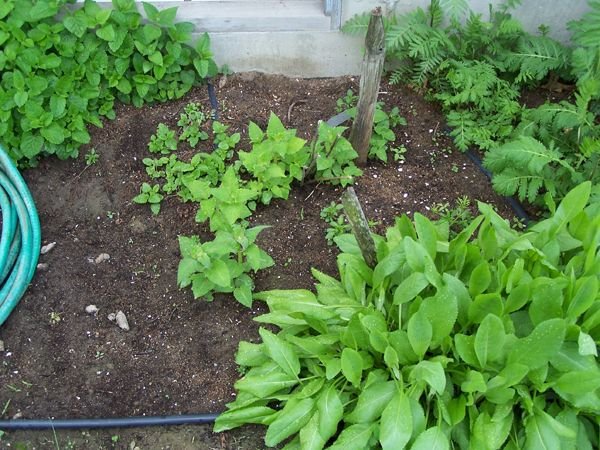
It’s just coming up in May 2006 in the old herb garden. You can see the lemon balm to the left is much more vigorous.
Sometime around 2005 I planted it in the 2nd fence garden. It was a maroon variety. It did very well there as it had full sun.
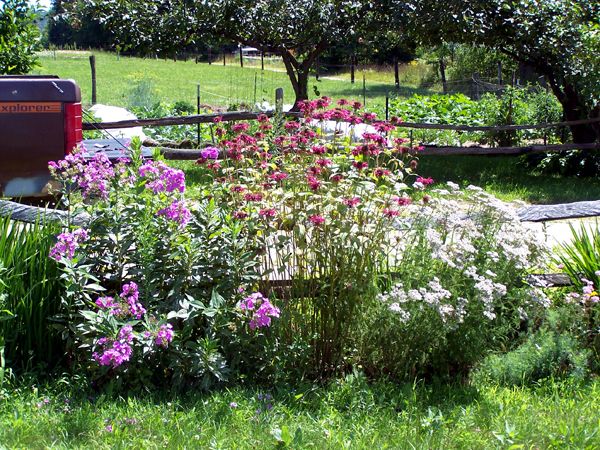
Fence garden August 2009
Monarda didyma L., aka Bee Balm, Oswego tea, Indian plume, fragrant balm, mountain mint, sweet bergamot, scarlet bergamot, wild bergamot or monarda, is a hardy perennial herb from which you can use the leaves and flowers. It grows 2’ – 5’ high and can be found in wet places, streambanks, woods, and thickets. Zone 3 – 9.
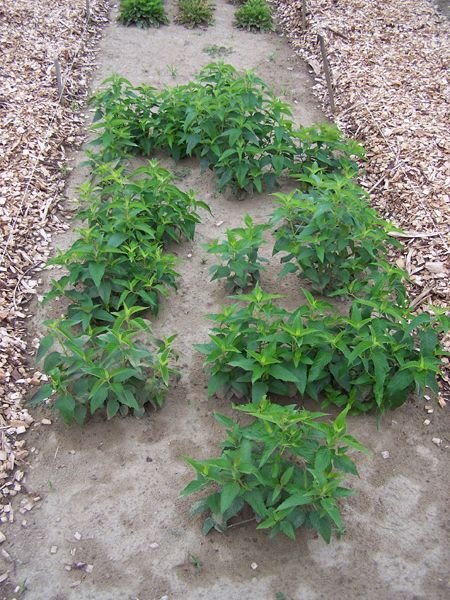
New Herb garden August 2016
I planted it in the New Herb garden when I created it in 2016. It did pretty well in the poor soil during a year long drought.
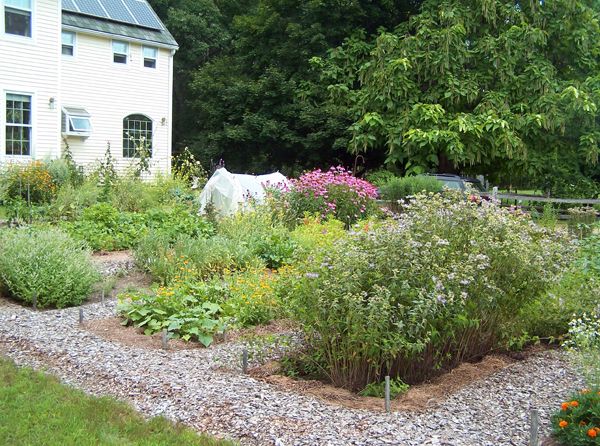
New Herb garden August 2017
The drought broke early in 2017 and I was also able to amend the soil and put down cover crops and mulch. When it flowered I discovered I had a lavender variety, not the red I expected. It has done very well with the soil improvements.
This plant is susceptible to powdery mildew and I have had real problems with that over the years. Two years ago we tried a raw milk:water solution of 1:10 and sprayed thoroughly once a week in early morning. It really knocked the mildew back on these plants. It eliminated it on other types of plants also.
I am hoping as the soil improves in the New Herb garden the disease problems will disappear.
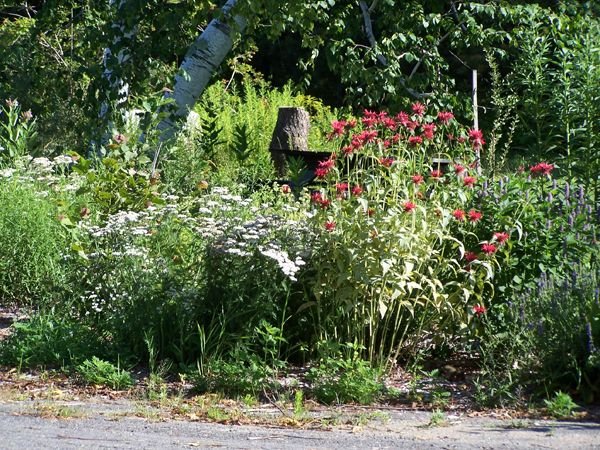
Benson’s July 2015
Flowers: Bright red/crimson/scarlet pompom flowerheads, flowers June – September, 2” across
Leaves: Dark green, oval, opposite leaves emit strong scent when disturbed, up to 6” long on square stems, paired with reddish veining
Cultivation: Prefers moist, rich soil, as in woods. Sun or part shade. Mulch in dry areas.
Divide or take root cuttings in the spring, stem cuttings in the summer. Divide every 3 years, discarding dead center.
Sow seed in spring. Thin to 18” apart. Germination in 10 days at 70F, Seed life: 2 years. 60 days to harvest.
Not drought tolerant or suited for indoor growing.
Medicinal: Leaves and flowers for teas for sore throats, nausea, gas, insomnia
Culinary: Use the flowers and leaves in salads, stuffing, on pork, in lemonade, and in jams and jellies.
Other: The citrus smell attracts butterflies and hummingbirds. The oil is used in perfumes. Dry flowers and leaves for potpourri. The best scent is when leaves are young and flowers just open.
I’ve dehydrated the leaves and flower rays to feed to the layers over the winter.
There are many medical uses for this plant, but I’ve not yet tried any.
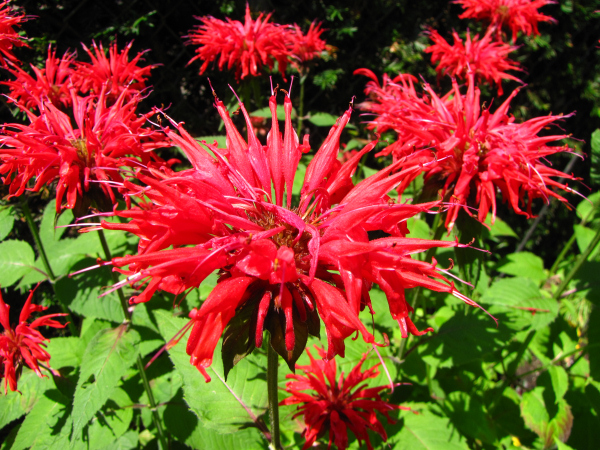
References:
Taylor’s Perennials page 135
Field Guide to Herbs page 216
Right Plant, Right Place page 199
HP Perennials page 125
Encyclopedia of Herbs pages 276 – 277
Herbs pages 61, 204
TC Perennials pages 8, 68, 131
Wild Flowers page 190
Complete Book of Herbs pages 97, 236, 250
Fresh Eggs Daily - Herbs for Hens™: Bee Balm
Credits:
Photo: flower of Bee Balm Plant (Monarda) @ NellsWiki

Community Forums
Excited to see this post! I have little seedlings in the grow tent right now of bee balm. This is my first year ever growing it and I can't wait to see the blooms start later this season.
Beautiful herb garden!
I grew the red and dwarf purple in Tennessee and truly enjoyed it. I need to start me some here. I remember having mildew problems with the red but we had a sprinkler system then and I always that the overhead watering caused it. Your gardens are beautiful and I have never eaten or used them, but looks like I should consider it. Thank you for posting the uses of leaves and flowers.
Oddly enough, the mildew was FAR worse during our year of drought than during our years of rain. Counter-intuitive, right? And I read many people experienced the same during that year of drought.
i like your remedy against powdery mildew! SOme plants are definitely more susceptible and I often just take them out of the garden altogether. Certain phlox can get so ratty from the mildew, and also I stopped growing zinnias cuz of the mildew. But I LOVE zinnias! Such perky cut flowers.
Yes, those 2 also have issues, but the raw milk solution worked really well on them. Stopped the mildew dead on the phlox. It also kept the rust on the hollyhocks in check all season.
Congratulations! This post has been added to our growing directory of Steemit "how to" posts for the Homesteading/Survival/Foraging/Prepper communities. If you haven't done so already, you can claim your badge along with the code to add to your posts to let the world know you have chosen to help others Survive, Thrive and be Prepared! Click here to get the code